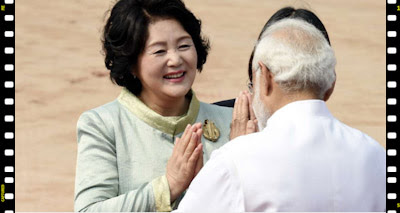Ayodhya, which is best known as the origination of the Hindu god Ram, additionally notwithstanding, holds uncommon criticalness for some South Koreans - many trust they can follow their family line to the city.
This conviction originates from a few verifiable Korean stories which recounts the narrative of an Indian princess - Suriratna - who wedded a South Korean ruler and began a line.
What does the legend say?
As per the legend, Princess Suriratna, otherwise called Heo Hwang-alright, went to Korea in 48 AD, somewhere in the range of 2000 years back, and began the Karak administration by wedding a nearby lord.
Some Chinese-dialect writings guarantee that the then King of Ayodhya had a fantasy where God requested him to send his 16-year-old little girl to Gimhae city in South Korea to wed King Kim Suro.A well known South Korean book involving tales and recorded stories, Samguk Yusa (Memorabilia of the Three Kingdoms), makes reference to that Queen Hwang-alright was the princess of "Ayuta" kingdom
The regal couple flourished. They had 10 children and both lived to be over a 150 years of age.An anthropologist named Kim Byung-mo Ayuta seemed to affirm the broadly held conviction that Ayuta was really Ayodhya, as the two names are phonetically comparable.
Korean reunions: Families separated by war meet in North
However, there is no reasonable proof to demonstrate that the princess even really existed. Her starting point story is viewed as legendary and isn't viewed as history by scholastics," says David Cann of the BBC's Korean Service. There have been a few anecdotal interpretations of the story as there is a lot of space for creative energy."
The Karak line
Kim is a typical surname in Korea and King Kim Suro is viewed as the dad of the Kim family which is situated in Gimhae. "While customarily youngsters in Korea take their dad's surname, the ruler is said to have been pitiful that her kids couldn't bear her surname," says Minji Lee of the BBC Korean Service.
"The legend says that along these lines King Suro enabled two of their children to take her name (Heo), which is utilized to this day."Today, students of history say, relatives of the couple number in excess of six million, which is generally about 10% of the South Korean populace.
Individuals from the Karak administration have likewise safeguarded the stones that are said to have been utilized by the princess amid her ocean voyage to Korea to keep her pontoon stable. Previous South Korean presidents Kim Young-sam and Kim-Dae Jung, and previous head administrator Kim Jong-Pil guarantee their family to the Karak tradition.
Is the legend mainstream in South Korea?
A portion of our associates in the BBC Korean Service say that they have heard in regards to this legend however don't trust it's a broadly discussed story since "it returns so far before". I caught wind of it when I was in elementary school or middle school and my companions and I were captivated how our family includes somebody from so far away," says Ms Lee. Some say that there is hypothesis that the princess is really from Thailand since Ayuta may really be Thailand's Ayutthaya Kingdom.
Stories on the web say that a few people from Gimhae allude to this legend "like a family joke" particularly on the off chance that they have darker skin, crediting it to their "precursor who might possibly have originated from India". Some trust that while the facts may confirm that she originated from a 'southern nation over a sea' the story was vigorously adorned when Buddhism flourished in Korea," says Mr Cann, who additionally went for a melodic version of the legend as a tyke.
An understanding was marked to create Ayodhya and Gimhae as sister urban communities in 2000. At that point in 2001, in excess of 100 students of history and government agents, including the North Korean diplomat to India, uncovered Queen Hwang-alright's dedication on the west bank of the River Saryu in Ayodhya. Consistently, individuals who guarantee to be from the ruler's ancestry come to Ayodhya to pay tribute to the princess at her homeland.
The Mughal ruler who turned into a women's activist symbol
In 2016, a Korean appointment sent a proposition to the Uttar Pradesh government to additionally build up the remembrance. As a component of her visit from 4 to 7 November, the principal woman will go to a service that denotes a begin on the overhaul of the landmark - a joint venture between South Korea and India.Prof Kim-do Young, a Delhi-constructed master in light of Korean investigations, says this common history began being perceived in India "after conciliatory and monetary relationship" between the two nations created.
"Regardless of whether it is history or legend - in view of it - mental or otherworldly hole [between the people] is diminished and a typical social ground is made," he includes, bringing up that it's fascinating that there possibly an "antiquated bond" between the two countries. Ruler Hwang-alright's story has been and can be the "establishment for building better relations" between South Korea and India.







No comments:
Post a Comment